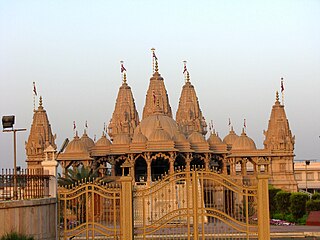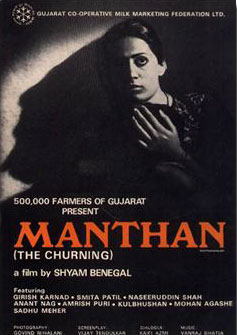
The Parsis or Parsees are an ethnoreligious group of the Indian subcontinent adhering to Zoroastrianism. They are descended from Persians who migrated to Medieval India during and after the Arab conquest of the Persian Empire to escape religious persecution. The Parsi people comprise the older of the Indian subcontinent's two Zoroastrian communities vis-à-vis the Iranis, whose ancestors migrated to British-ruled India from Qajar-era Iran. According to a 16th-century Parsi epic, Qissa-i Sanjan, Zoroastrian Persians continued to migrate to the Indian subcontinent from Greater Iran in between the 8th and 10th centuries, and ultimately settled in present-day Gujarat after being granted refuge by a local Hindu king, Jadi Rana.

Gujarat is a state along the western coast of India. Its coastline of about 1,600 km (990 mi) is the longest in the country, most of which lies on the Kathiawar peninsula. Gujarat is the fifth-largest Indian state by area, covering some 196,024 km2 (75,685 sq mi); and the ninth-most populous state, with a population of 60.4 million in 2011. It is bordered by Rajasthan to the northeast, Dadra and Nagar Haveli and Daman and Diu to the south, Maharashtra to the southeast, Madhya Pradesh to the east, and the Arabian Sea and the Pakistani province of Sindh to the west. Gujarat's capital city is Gandhinagar, while its largest city is Ahmedabad. The Gujaratis are indigenous to the state and their language, Gujarati, is the state's official language.

Bharuch, formerly known as Bharutkutccha, is a city at the mouth of the river Narmada in Gujarat in western India. Bharuch is the administrative headquarters of Bharuch District.
Patel is an Indian surname or title, predominantly found in the state of Gujarat, representing the community of land-owning farmers and later businessmen, agriculturalists and merchants. Traditionally the title is a status name referring to the village chieftains during medieval times, and was later retained as successive generations stemmed out into communities of landowners. There are roughly 500,000 Patels outside India, including about 150,000 in the United Kingdom and about 150,000 in the United States. Nearly 1 in 10 people of Indian origin in the US is a Patel.

Mehsana, also spelled Mahesana, is a city and Municipal corporation in Mehsana district, in the Indian state of Gujarat. Established in 14th century, the city was under Gaekwads of Baroda State from 18th century to the independence of India in 1947. The municipality was established in 1919–20 and the plan to form Municipal Corporation was announced in 2024. The town has population of about 185,000. Dairy, oil and natural gas are major industries while there are several small and medium enterprises in the city.

Anand is the administrative centre of Anand District in the state of Gujarat, India. It is administered by Anand Municipal Corporation. It is part of the region known as Charotar, consisting of Anand and Kheda districts.

Palanpur is a city and a municipality of Banaskantha district in the Indian state of Gujarat. Palanpur is the administrative headquarters of Banaskantha district. Palanpur is the ancestral home to an industry of Indian diamond merchants.

Manthan, also released under the translated title The Churning, is a 1976 Hindi film directed by Shyam Benegal, inspired by the pioneering milk cooperative movement of Verghese Kurien, and is written jointly by him and Vijay Tendulkar. It is set amidst the backdrop of the White Revolution of India. Aside from the great measurable success that this project was, it also demonstrated the power of "collective might" as it was entirely crowdfunded by 500,000 farmers who donated Rs. 2 each. Manthan is the first crowdfunded Indian film.

The Bardoli Satyagraha, was a farmers' agitation and nationalist movement in India against the increased taxation of farmers by the colonial government. It demanded a cancellation of the 22% tax hike being levied in Bombay Presidency. The movement began on 12 June 1928. It was eventually led by Sardar Vallabhbhai Patel, and its success gave rise to Patel becoming one of the main leaders of the independence movement.

The Story of Sanjan is an account of the early years of Zoroastrian settlers on the Indian subcontinent that was originally written in 1599 CE by Parsi priest, Bahman Kaikobad. In the absence of alternatives, the text is generally accepted to be the only narrative of the events described therein, and many members of the Parsi community perceive the epic poem to be an accurate account of their ancestors.

According to the 2011 national census, the population of Ahmedabad was declared to be 7,214,225. This figure was only limited to the municipality region. The total population of the Ahmedabad Urban Agglomeration came to 7.2 million people. There were 886 females to every 1000 males in 2001. Now there are 904 women to 1000 men in 2011. Ahmedabad had a literacy rate of 79.89% in 2001 which rose to 89.62 percent in 2011. Out of this, male and female literacy are 93.96 and 84.81 percent as of 2011 census. According to the census for the ninth plan, there are 30737 rural families living in Ahmedabad. Out of those, 5.41% live below the poverty line. There are 439,843 people who live in slums in the city. The majority of residents of Ahmedabad are native Gujaratis and speak Gujarati. There is also a sizable population of Punjabis, Marathis, Tamils, Sindhis, Malayalis and Marwaris who bring in their native language and culture to the city. The government institutions and military base near the city also bring peoples from across India. The city's population has increased in a major way following increasing economic expansion and modernization.
The Gujarati people, or Gujaratis, are an Indo-Aryan ethnolinguistic group who reside in or can trace their ancestry or heritage to a region of the Indian subcontinent primarily centered in the present-day western Indian state of Gujarat. They primarily speak Gujarati, an Indo-Aryan language. While Gujaratis mainly inhabit Gujarat, they have a diaspora worldwide. Gujaratis in India and the diaspora are prominent entrepreneurs and industrialists and maintain high social capital. Many notable independence activists were Gujarati, including Mahatma Gandhi and Vallabhbhai Patel.
Nandarkha is a village situated in the Navsari district of the Indian state of Gujarat. It is positioned in the southwestern region of the Navsari district, lying between the towns of Bilimora and Chikhli.
The term Gujarati Muslim is usually used to signify an Indian Muslim from the state of Gujarat in western coast of India. Most Gujarati Muslims have the Gujarati language as their mother tongue, but some communities have Urdu as their mother tongue. The majority of Gujarati Muslims are Sunni, with a minority of Shi'ite groups.
Alipor is a village near Chikhli, Bilimora in the state of Gujarat in western India. The village is on the Indian National Highway 8, which leads to areas such as Ahwa via Waghai and Vansda, and to the hill station of Saputara.
The culture of Gujarat is both ancient, new, and modern.
Variav is a village in Surat District, Gujarat, India. Variav is on the right bank of Tapti River. Variav was recently added to the region of Surat Municipal Corporation, and is now a suburb of Greater Surat.
Shapur is a village in Vanthali taluk in Junagadh district in the Indian state of Gujarat. This region is known as "Sorath", after the former Princely State of Junagadh.
Hadmatiya is a village in the Rajkot district of the Indian state of Gujarat located 21 kilometres (13 mi) from the city of Jamnagar.

Saldi is a village in the Mehsana District, Gujarat, India, Pin Code 382730, situated on State Highway 217 between Gandhinagar and Mehsana. Saldi represents a typical countryside village of India. It borders the following villages: langhnaj, Veda, Parsa, Charadu, Vadasma, Shankarpura, Khata Amba, Khoraj and Himatpura. Saldi is famous for its temple of Pimpleshwar Mahadev, also known as Saldiya Mahadev.











